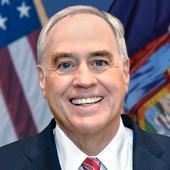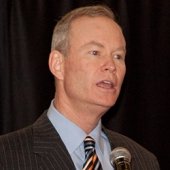Protiviti's Claire Gotham and Tyler Chase on powering the city of the future
IN BRIEF
- The rapid growth of cities, which currently consume 78% of the planet’s primary energy, electricity use is going to soar in the coming years.
- Nonprofit Rewiring America has predicted the creation of 25 million new jobs of all types in the United States over the next 15 years, with five million sustained jobs by mid-century.
- As IoT grows exponentially, data platforms will become more important in ensuring the energy needed to run a city in 2030 will be available, sustainable, reliable and distributed equitably.
Amanda, a thirty-something professional, is a typical urban dweller in the year 2030. She wakes up each morning in a city apartment that is served mostly by electricity—but the sources of that power are quite varied. A heat pump from the coffee roastery in the building next door provides much of the space heating for her apartment. A photovoltaic cell on her balcony supplies the power for her coffee maker and other small appliances. Her tiny apartment and electric vehicle (EV), which has been charging overnight in the underground parking garage, both receive much of their energy from the local utility. The utility, in turn, generates its electricity largely from renewables such as wind power and solar panels.
Amanda is not just an energy consumer. She is also an energy provider through her building’s microgrid, which sells excess electricity back to the utility. The microgrid, which serves both residents and a data center business on the ground floor of Amanda’s building, is composed of EVs, photovoltaic cells, rooftop solar panels, and behind-the-meter batteries and generators used for emergency backup—a closed-loop system that provides minute-by-minute transparency via a building power dashboard and can be controlled by the users.
Unlike power consumers of today, Amanda enjoys energy supplied by a grid that is largely self-sufficient, resilient and green. If the local utility should suffer from equipment outages or overloads, her microgrid and those of neighboring buildings can pick up much of the slack. Moreover, her carbon footprint is a fraction of the typical consumer of 2021. Living in a compact city where multiple-use zoning is the rule, she can find practically every lifestyle need within a 15-minute ride.
If this scenario sounds too idealized, bear in mind that most of the technology to achieve it already exists. The real question is whether 21st-century cities will embrace the policy and business decisions that will turn sustainable energy into a reality.
Economic, climate and societal pressure is building to push for this future. Based on a number of indicators, such as the rapid growth of cities, which currently consume 78% of the planet’s primary energy, electricity use is going to soar in the coming years. Burgeoning technologies like EVs and distributed ledger systems (e.g., cryptocurrency) will need massive amounts of power, as will all the data centers that form the backbone of the digital economy. And legacy technologies, such as air conditioners, are not going to disappear overnight, which means the hunger for energy—and for renewable sources of that energy—will grow for the foreseeable future. For example, the International Energy Agency has forecast that the number of installed air conditioners will grow by two-thirds from the 2 billion units currently installed.
Climate change is a pressing point. As the planet warms, not only is the need for cooling technologies growing, but extreme weather events are causing widespread disruptions in electricity supply. Electric grids with built-in resilience are becoming a necessity, and yet the current model of centralized, often-remote energy generation and long-distance transmission is not set up to meet that need. A new generation of power companies is capitalizing on this weakness of traditional utilities by grabbing large sections of the power market, such as airports, hospitals and school districts, which depend on reliable energy, and supplying them with efficient, reliable, locally generated and locally stored energy—typically from clean and renewable sources such as wind and solar. These disruptors are growing in number and market share, with a projected market value compound annual growth rate of 27% for the next six years.
And then there is the customer, who with each passing year is having a greater influence on the future of energy. Whether through Wall Street, Main Street or government, the investing, buying and voting public wants to know the source of its electricity. A number of cities, such as San Francisco, already offer utility customers green energy options. And much like the organic food movement of the last century, consumers are indicating that they will pay more for personal and community health.
Climate change is a pressing point. As the planet warms, not only is the need for cooling technologies growing, but extreme weather events are causing widespread disruptions in electricity supply.
Future-enabling energy policies
While stakeholders ranging from government and business leaders to consumers and community activists appear as the face of the sustainable energy movement, economic forces in and of themselves are driving 21st-century economies toward renewable energy and electrification. The banking firm Goldman Sachs has forecast that investment in the clean energy sector will hit $16 trillion through 2030, surpassing fossil fuels. In line with those figures, Rewiring America, a nonprofit organization devoted to complete electrification of the country, has predicted the creation of 25 million new jobs of all types in the United States over the next 15 years, with five million sustained jobs by mid-century.
Government leaders are facilitating the transition toward renewables through such measures as stricter vehicle emission standards, phase-out programs for internal combustion engine vehicles, and subsidized campaigns to build widespread access to EV charging stations. The United Kingdom, for its part, has created Clean Air Zones (CAZs) on its roads and in its cities where polluting vehicles must pay a toll.
Partnerships between utilities and governments at all levels further promote electrification of final energy use. For example, a number of investor- and government-funded grid modernization projects are underway in the United States to make grids more responsive to changes in demand and supply, and to connect with and optimize input from microgrids. Currently, obtaining regulatory approval for such utility expenditures takes an average of 13 months.
Much wider partnerships involving government and businesses of all kinds could dramatically improve energy efficiency through the development of compact cities. With better land use, consolidated urban housing, and multiple-use buildings, cities can produce fewer emissions, require far less energy and promote healthier and happier lifestyles. Stockholm and Pittsburgh, for example, have comparable populations, but Pittsburgh sprawls over five times more land than Stockholm and produces five times the amount of emissions per resident. By contrast, Stockholm’s compactness enables it to produce a flourishing economy and a well-regarded quality of life.
These growing trends only touch the surface of policy shifts that could greatly enhance the energy efficiency of cities. Other changes include a circular economy approach that considers the energy use of all civic and infrastructure components, such as water, waste and building materials in comprehensive, interconnected ways, as well as cross-industrial synergies, such as those created by automakers and utilities working together to develop EVs and EV infrastructure.
The banking firm Goldman Sachs has forecast that investment in the clean energy sector will hit $16 trillion through 2030, surpassing fossil fuels.
Claire Gotham is a Managing Director at Protiviti and the Lead for Power & Utilities in North America. In her 25 years in the energy industry she has worked with senior leadership, to innovate on a wide range solutions across all segments of the industry, including risk, resiliency & sustainability.
Tyler serves as the global leader for Protiviti’s Energy & Utilities industry and has spent over 20 years focused on the wide ranging challenges in the industry. Tyler teams with a global network of experts across the Power & Utilities, Renewables, Oil & Gas, and Mining segments to stay ahead of trends and build solutions that enable success across the industry.
Did you enjoy this content? For more like this, subscribe to the VISION by Protiviti newsletter.



































